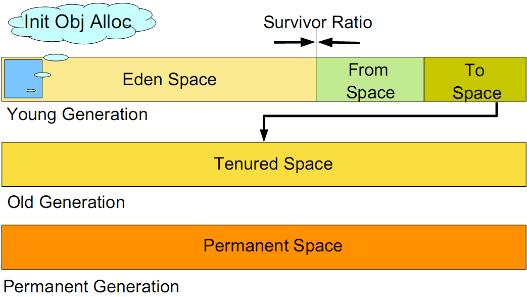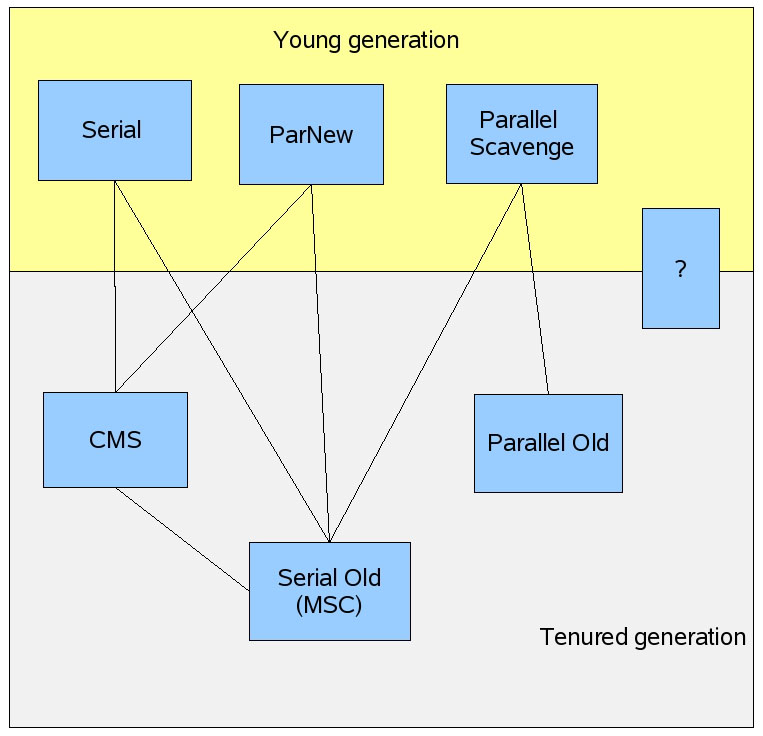Understand JVM GC
For us to understand the JVM GC control Java applications are of great help. Let me from the operation and maintenance point of view, the JVM online relevant information are summarized as follows, in order to deepen the understanding of the JVM GC. If the wrong place, please correct me Tell me.
JVM memory usage classification
JVM's memory partition relationship:
- [JVM whole heap memory] = the young generation + old generation
- [JVM] = entire memory (heap memory) + non-heap memory = (the young generation + old generation) + permanent generation
About the young generation, the old generation, lasting generations
For the JVM, the memory is divided into three areas: the young generation, the old generation and permanent generation. The young generation and the old generation used to store Java process variables, lasting generations to put Java class information. We generally focus on the young generation and the old generation. JVM generational can use the following figure shows this:

The young generation is divided into three areas: a Eden area (referred to as E area), two Survivor area (which we define as S0, S1). Variables Java program new applications will be placed in E zone; when the E area is full, all surviving objects are moved to the S0 area. When S0 area is full, S0 surviving objects are moved to the S1 zone (S0 on the air this time, when the E area full-lived objects will move to S1 area). When S1 area is full, the experienced S0 object is moved to the old generation (O area). S0 and S1 zone area is like, such an object to enter the permanent generation will experience E area, S0 area, S1 zone, and then proceeds to O area.
Promoted from the young generation up objects (-> S0 area -> S1 Zone - E Zone> O area) for storing the old generation, in general, when we set the boss is relatively large.
Case jstat view the current Java process JVM districts
Instructions
jstat - gcutil process pid refresh sec s
Examples
[ hadoop @ localhost ~] $ jstat - gcutil 6572 1S
S0 S1 EOP YGC YGCT FGC FGCT GCT
0.00 0.13 10.61 60.38 63.44 249 117.204 2 1.468 118.673
0.00 0.13 10.61 60.38 63.44 249 117.204 2 1.468 118.673
0.00 0.13 10.61 60.38 63.44 249 117.204 2 1.468 118.673
0.00 0.13 10.61 60.38 63.44 249 117.204 2 1.468 118.673
0.00 0.13 10.61 60.38 63.44 249 117.204 2 1.468 118.673
0.00 0.13 10.61 60.38 63.44 249 117.204 2 1.468 118.673
0.00 0.13 10.61 60.38 63.44 249 117.204 2 1.468 118.673
0.00 0.13 10.61 60.38 63.44 249 117.204 2 1.468 118.673
0.00 0.13 10.61 60.38 63.44 249 117.204 2 1.468 118.673
0.00 0.13 10.61 60.38 63.44 249 117.204 2 1.468 118.673
Here you can see the individual usage situation S0, S1, E, O area, in addition to the number of gc statistics
GC relationship between the young generation and the old generation
Due to limited JVM memory, and Java application does not manage unused memory, so the need for a JVM garbage collection mechanism (Garbage Collection), this is the JVM GC mechanism. Current common GC collector summarized as follows:
| Memory area | GC algorithm | Are Multithreading | Whether the stop-the-world |
|---|---|---|---|
| The young generation | Serial | Threaded | It is |
| The young generation | ParNew | Multithreading | It is |
| The young generation | Parallel | Scavenge Multithreading | It is |
| Old generation | CMS | Multithreading | The whole process had 2 brief stop-the-world |
| Old generation | Serial Old (MSC) | Threaded | It is |
| Old generation | Parallel Old | Multithreading | unkown |
The young generation and the old generation has its own garbage collection mechanism. And when we actually use, they are with each other, specifically with the relationship shown below:
